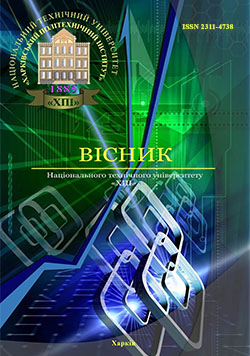MANAGEMENT OF ENVIRONMENT IN THE PROJECTS OF FOREIGN STUDENTS' TRAINING
DOI:
https://doi.org/10.20998/2413-3000.2017.1224.13Keywords:
project environment, persons which interested in the project, factors that determine the success of the projectAbstract
The work is devoted to topical issues – determine the feasibility of integrating process management in a complex dynamic environment, what is the environmental education for today. The authors show that in spite of the growing foreign demand for education services, there are still a number of environmental factors negatively influencing the process. The main conclusion is that the negative impact of external factors as significant because of the absence of an effective environment management system. One of the characteristics of quality management integration process proposed to use the indicator of the achieved level of interaction between stakeholders. Shown that the main task of the decision is to find a compromise between achievement in the desired level of control (influence) and overall organizational costs.
References
1. Bilokon A. I., Trifonov I. V. Upravlinnia proektamy i programamy restrukturyzatsii [Project management and rehabilitation programs]. Dnipropetrovsk, PDABA, 2008. 138 p.
2. Bilokon A. I., Malanchiy S. A., Alkubalait A. D. Teoreticheskie aspekty opredeleniya i vzaimodejstviya zaitresovannykh grup lits v proektakh [Theoretical aspects of the definition and collaboration of persons groups interested in the projects]. Visnyk Prydniprovskoi derzhavnoi akademii budivnytstva ta arkhitektury [Bulletin of Pridneprovska State Academy of Civil Engineering and Archicture]. Dnipropetrovsk, 2016, no. 1, pp. 71–77.
3. Bushuyev S. D., Morozov V. V. Dinamicheskoe liderstvo v upravlenii proektami [Dynamic leadership in project management]. Ukrainskaya assotsiatsiya upravleniya proektami [Ukrainian association of project management]. Kiev, 2000. 312 p.
4. Grashina M., Dunkan V. Osnovy upravleniya proektami [Basics of project management]. Stankt-Peterburg: Piter, 2006. 208 p.
5. Malanchiy S. A. Upravleniya processom vzaimodejstviya stejkholderov. Theory and practice of metallurgy. Dnipropetrovsk, NMAU, 2013, no 1–2 (90–91), pp. 186–188.
6. Yolker R. Managing the international project environment. International Journal of Project Management. 1992, vol. 10, iss. 4, pp. 219–226. doi : 10.1016/0263-7863(92)90081-J
7. Saati T., Kerns K. Analiticheskoe planirovanie. Organizatsiya system [Analytical planning. Organization of systems]. Moscow, Radio I svyaz’, 1991. 224 p.
8. Saati T. Prinyatie resheniy. Metod analiza ierarkhiy [Making decisions. Method of hierarchy analysis]. Moscow: Radio I svyaz’, 1993. 278 p.
9. Silvasti Yu. Upravlenie zainteresovanymi storonami [Management of interested parties]. Mir upravleniya proektami. Osnovy, metody, organizatsiya, primenenie [World of project management. Basics, methods organization and application]. Eds. Reschke J., Schell H. Moskva, Alans, 1993, pp. 188 – 192.
10. Husieva Yu. Yu., Kantsevych M. V. & Chumachenko I. V. Multysteikkholdernaia model upravlenyia kachestvom obrazovatelnoho proekta [Multi-stakeholder model of quality management in education project]. Visnyk Natsionalnoho tekhnichnoho universytetu «KhPI». Zbirnyk naukovykh prats. Seriia: Stratehichne upravlinnia, upravlinnia portfeliamy, prohramamy ta proektamy [Bulletin of the National Technical University "KhPI". Collection of scientific papers. Series: Strategic management, portfolio management, programs and projects]. 2015, 2, рр. 8–13.
Downloads
Published
Issue
Section
License
Copyright (c) 2017 Анатолий Иванович БЕЛОКОНЬ, Сергей Александрович МАЛАНЧИЙ, БАХРИ НАДХЕМ

This work is licensed under a Creative Commons Attribution-NonCommercial-ShareAlike 4.0 International License.
Our journal abides by the Creative Commons copyright rights and permissions for open access journals.
Authors who publish with this journal agree to the following terms:
Authors hold the copyright without restrictions and grant the journal right of first publication with the work simultaneously licensed under a Creative Commons Attribution-NonCommercial-ShareAlike 4.0 International License (CC BY-NC-SA 4.0) that allows others to share the work with an acknowledgement of the work's authorship and initial publication in this journal.
Authors are able to enter into separate, additional contractual arrangements for the non-commercial and non-exclusive distribution of the journal's published version of the work (e.g., post it to an institutional repository or publish it in a book), with an acknowledgement of its initial publication in this journal.
Authors are permitted and encouraged to post their published work online (e.g., in institutional repositories or on their website) as it can lead to productive exchanges, as well as earlier and greater citation of published work.

